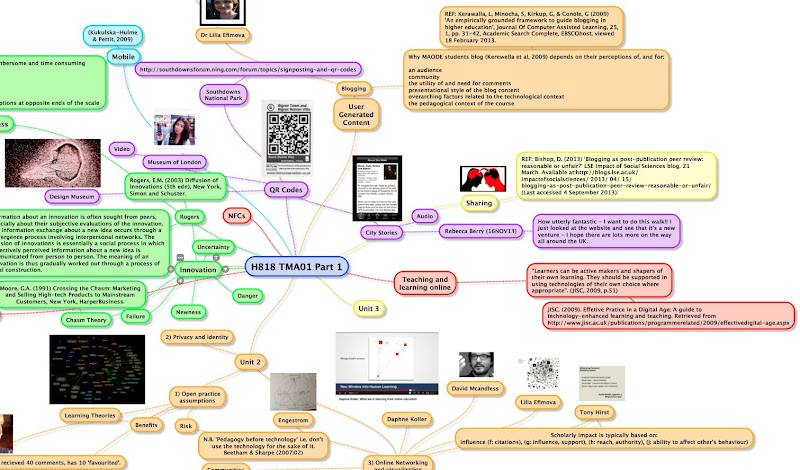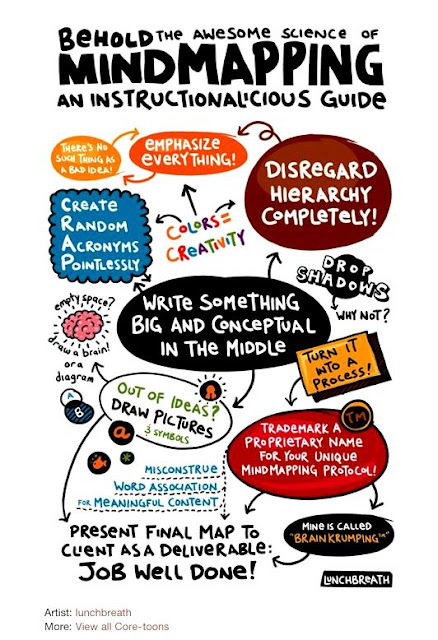Home » Posts tagged 'mind map'
Tag Archives: mind map
My Personal Learning Environment. What’s yours?
I should look back at how this has changed over four years. Taking on more technology took a while. I remember the days of printing off. Then I migrated to an iPad and constantly looked at ways not to come offline ever. Now I mix it all up: I use a white board, I doodle in a notepad and I shift between devices as everything is done in Google Docs.
I have some favourite apps:
SimpleMinds
Studio
And load perhaps 50-100 pictures to Picasa Web Gallery every day … there are over 2000 images and screen-grabs from the MAODEs alone. And far too many pictures of the dog hiding when I take her for a walk.
My only bete noire are the ruddy cables you need to supply power to the kit; I went away for a few days armed with iPad and Macbook Air but forget the charger for the laptop. The iPad cable feels as if I am packing a coil of rope – it ways more with the plug and takes up more space.
My test over the next couple of months is when I set off for a month to Belgium, France and the Alps. Will I hanker after a robust broadband signal all the time?
Using SimpleMinds multi-media mindmap as a concept board for a Tutor Marked Assignment (TMA) on the Open University module ‘The Networked Practitioner’
 |
| From E-Learning III |
 |
| From E-Learning III |
 |
| From E-Learning III |
Fig.1. SimpleMinds+ concept board/mind map for H818 TMA 01
Sometimes it is too much fun. Actually writing the assignment is such an anticlimax. Sometimes the tool offers too much. SimpleMinds (Free) does the job more the adequately. Here I got mesmerized by the ability to add pictures … which might be a visual aide memoir but are unnecessary and unlikely to make it into the assignment. Though I do believe in illustrating the thing if I can. However, given the module I’ll have to be very sure indeed where I stand on the creative commons for any images used.
There’s a mash-up here from a publicity piece on the Museum of London using an application called Studio – I ought to attribute both.
There’s a photo I took in the Design Museum.
To confuse the visitor some parts of this show permitted photography, some didn’t – this did, but I don’t know on what basis. In the centre there is a complex SimpleMind of my own on 13 learning theories (there are possibly only five or six, but I stretched the thinking a bit) I ought to have a creative commons licence on it of some kind so that a) I receive attribution b) there is no commercial use c) there is no chopping it about. ie. CC attribution, no commercial, share alike?
Creative Problem Solving Techniques Library : Random Stimuli (Dali Champagne)
B822 Techniques Library : Random Stimuli of Various Kinds
1) Identify what it is you want ideas for.
2) Grab an idea from a paper, from looking out of the window, or by throwing dice. (In our case the facilitator had a collection of odd items for this purpose).
3) Connect this idea back to the issue, if necessary using Free Association or Excursion.
4) If it doesn’t work try something else.
Could pick a fixed or specific element of the problem and do the same.
* Select grammatically appropriate stimuli: noun+verb, adjective+noun, but make bizarre combinations (which is how David Bowie often wrote song lyrics).
* Deliberately do something different, or speak to someone new or travel home in a different way.
* Allow the idea to incubate while going about your normal day.
CASE STUDY
We took a business problem and defined this in a way that was clear.
WRITTEN UP ON FLIP CHART
Various items were picked out from a selection brought to the workshop by the tutor for this purpose. He picked out a small, smiling lobster ornament as the stimuli and passed it around. We then played collective word association writing our word onto a PostIt note that the facilitator then put onto a set of double doors.
Once we had around 70 ideas and we had fairly exhausted our thoughts we stopped.
The role of the facilitator was to ensure that everyone offered ideas, that no one dominated. Collectively we put the words into groups and labelled these groups.
We took ONE theme and put it on a triple A1 sheet of paper.
We drew, collectively, a mind map still trying to generate ideas.
Finally, from these ideas the person whose problem it had been was invited to see if any answers had been offered.
The solution that was of most interest was indeed something that would not otherwise been thought of.
REFERENCE
Whiting (1958), Taylor (1962), de Bono (1970), Rickards (1974) and VanGundy
Six ways to debunk the mindmap in favour of the essay plan
I Loved this offered by fellow OU Student.
Mind maps can be such twaddle.
For a few days I taught Tony Burzan in Secondary Schools; the best mind map wasn’t a mind map at all, it was a football field.
I was not invited to continue with my efforts to teach memory tricks and cheats after that my second only effort to occupy 40 Year 9s.
Another blog, another day …
An eventful seven hours or so. Despite the need for an essay plan, bullet points or an ordered list.
I tried to write a TMA from a mind map and got myself as ludicrously tied in knots as it is with unlinked threads and a failure to group the content; a Venn Diagram would have worked better. Which is a point as applicable to the software that creates these things, know your tools and choices and make them. Sometimes the old, simple ways work best. Essays and assignments, like a narrative, are linear.
My A’ level Geography teacher Mr D.Rhodes of the Newcastle R.G.S had the best approach.
An essay should look like a flower
- six petals = six ideas
- the stamen = the topic
- the stem = the introduction and conclusion.
A shorthand doodle at the end of an essay would often feature such a flower with ONE huge leaf until I got the picture. It must have worked; how else did I get into Oxford?
An essay plan or treatment, unlike a mind-map, requires effort, concentration and thought.
Six ways to debunk the mindmap in favour of the essay plan
I Loved this offered by fellow OU Student.
Mind maps can be such twaddle.
For a few days I taught Tony Burzan in Secondary Schools; the best mind map wasn’t a mind map at all, it was a football field.
I was not invited to continue with my efforts to teach memory tricks and cheats after that my second only effort to occupy 40 Year 9s.
Another blog, another day …
An eventful seven hours or so. Despite the need for an essay plan, bullet points or an ordered list.
I tried to write a TMA from a mind map and got myself as ludicrously tied in knots as it is with unlinked threads and a failure to group the content; a Venn Diagram would have worked better. Which is a point as applicable to the software that creates these things, know your tools and choices and make them. Sometimes the old, simple ways work best. Essays and assignments, like a narrative, are linear.
My A’ level Geography teacher Mr D.Rhodes of the Newcastle R.G.S had the best approach.
An essay should look like a flower
- six petals = six ideas
- the stamen = the topic
- the stem = the introduction and conclusion.
A shorthand doodle at the end of an essay would often feature such a flower with ONE huge leaf until I got the picture. It must have worked; how else did I get into Oxford?
An essay plan or treatment, unlike a mind-map, requires effort, concentration and thought.
What does learning look like ?
Fig.1. What learning looks like. As I find it, or a model for creating an online learning platform?
I have for four weeks avoided printing anything off for H808. There has been no need.
However. So that I have it in front of me, Blu-tacked to the wall, I am printing off
The processes of writing reflectively: a map of reflective writing. Moon (1999a) Appendix 1 in Moon (2001)
And the Kolb Cycle. Kolb (1984)
This, as well as doing as I intended a month ago, drawing a simple knowledge-map by way of a treatment into a pad of A5 paper before I write in here may be how I do things here on in.
Dull, but dutiful?
REFERENCE
Kolb, D (1994) Experiential Learning as the Science of Learning and Development, Prentice Hall, Englewood Cliffs, NJ
Moon, J (1999a) Learning Journals: a Handbook for Academics, Students and Professional Development, Kogan Page, London
Moon, J. (2001) ‘PDP working paper 4: reflection in higher educationlearning’ (online), The Higher Education Academy. Available from:http://www.heacademy.ac.uk/assets/York/documents/resources/resourcedatabase/id72_Reflection_in_Higher_Education_Learning.rtf(Accessed 26 SEPT 2010).

